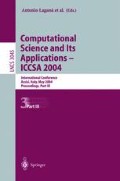Abstract
Given a number of obstacles in a plane, the problem of computing a geodesic (or the shortest path) between two points has been studied extensively. However, the case where the obstacles are circular discs has not been explored as much as it deserves. In this paper, we present an algorithm to compute a geodesic among a set of mutually disjoint discs, where the discs can have different radii. We devise two filters, an ellipse filter and a convex hull filter, which can significantly reduce the search space. After filtering, we apply Dijkstra’s algorithm to the remaining discs.
Access this chapter
Tax calculation will be finalised at checkout
Purchases are for personal use only
Preview
Unable to display preview. Download preview PDF.
References
Asano, T., Asano, T., Guibas, L., Hershberger, J., Imai, H.: Visibility of disjoint polyongs. Algorithmica 1, 49–63 (1986)
Alexopoulos, C., Griffin, P.M.: Path planning for a mobile robot. IEEE Transactions on Systems, Man, and Cybernetics 22(2), 318–322 (1992)
Edelsbrunner, H., Guibas, L.J.: Topologically sweeping an arrangement. J. Comput. System Sci. 38, 165–194 (1989)
Gavrilova, M.: On a nearest-neighbor problem under Minkowski and power metrics for large data sets. The Journal of Supercomputing 22, 87–98 (2002)
Ghosh, S.K., Mount, D.: An output sensitive algorithm for computing visibility graphs. SIAM J. Comput. 20, 888–910 (1991)
Kapoor, S., Maheswari, S.N.: Efficient algorithms for Euclidean shortest paths and visibility problems with polygonal obstacles. In: Proc. 4th Annu. ACM Sympos. Comput. Geometry, pp. 178–182 (1988)
Kim, D.-S., Kim, D., Sugihara, K.: Voronoi diagram of a circle set from Voronoi diagram of a point set: I. Topology. Computer Aided Geometric Design 18, 541–562 (2001)
Kim, D.-S., Kim, D., Sugihara, K.: Voronoi diagram of a circle set from Voronoi diagram of a point set: II. Geometry. Computer Aided Geometric Design 18, 563–585 (2001)
Mitchell, J.S.B.: Shortest paths among obstacles in the plane. In: Proc. 9th Annu. ACM Sympos. Comput. Geom., pp. 308–317 (1993)
Mucke, E.P., Saias, I., Zhu, B.: Fast randomized point location without preprocessing in two- and three-dimensional Delaunay triangulations. In: Proc. 12th Annu. ACM Sympos. Comput. Geom, pp. 274–283 (1996)
Okabe, A., Boots, B., Sugihara, K., Chiu, S.N.: Spatial Tessellations Concepts and Applications of Voronoi Diagrams. John Wiley & Sons, Chichester (2000)
Pocchiola, M., Vegter, G.: Computing visibility graphs via pseudo-triangulations. In: Proc. 11th Annu. ACM Sympos. Comput. Geom., pp. 248–257 (1995)
Pocchiola, M., Vegter, G.: Minimal tangent visibility graphs. Computational Geometry Theory and Applications 6, 303–314 (1996)
Preparata, F.P., Shamos, M.I.: Computational Geometry: An Introduction. Springer, New York (1985)
Rimon, E., Koditschek, D.E.: Exact robot navigation using artificial potential functions. IEEE Transactions on robotics and automation 8(5), 501–518 (1992)
Rohnert, H.: Shortest paths in the plane with convex polygonal obstacles. Inform. Process. Lett. 23, 71–76 (1986)
Rohnert, H.: Time and space efficient algorithms for shortest paths between convex polygons. Inform. Process. Lett. 27, 175–179 (1988)
Storer, J.A., Reif, J.H.: Shortest paths in the plane with polygonal obstacles. Journal of the Association for Computing Machinery 41(5), 982–1012 (1994)
Sudarshan, S., Rangan, C.P.: A fast algorithm for computing sparse visibility graphs. Algorithmica 5, 201–214 (1990)
Sundar, S., Shiller, Z.: Optimal obstacle avoidance based on the Hamilton-Jacobi- Bellman equation. IEEE Transactions on robotics and automation 13(2), 305–310 (1997)
Author information
Authors and Affiliations
Editor information
Editors and Affiliations
Rights and permissions
Copyright information
© 2004 Springer-Verlag Berlin Heidelberg
About this paper
Cite this paper
Kim, DS., Yu, K., Cho, Y., Kim, D., Yap, C. (2004). Shortest Paths for Disc Obstacles. In: Laganá, A., Gavrilova, M.L., Kumar, V., Mun, Y., Tan, C.J.K., Gervasi, O. (eds) Computational Science and Its Applications – ICCSA 2004. ICCSA 2004. Lecture Notes in Computer Science, vol 3045. Springer, Berlin, Heidelberg. https://doi.org/10.1007/978-3-540-24767-8_7
Download citation
DOI: https://doi.org/10.1007/978-3-540-24767-8_7
Publisher Name: Springer, Berlin, Heidelberg
Print ISBN: 978-3-540-22057-2
Online ISBN: 978-3-540-24767-8
eBook Packages: Springer Book Archive

